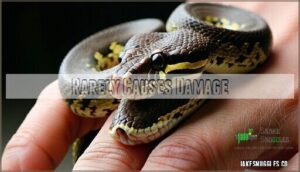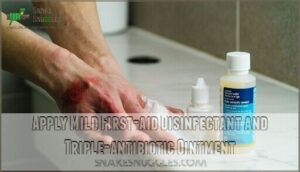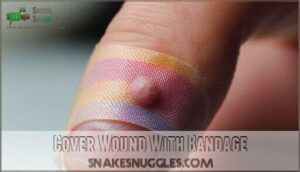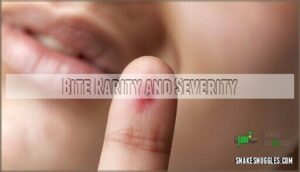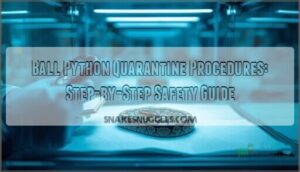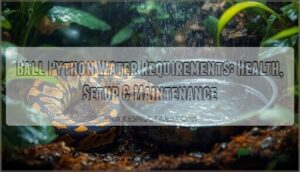This site is supported by our readers. We may earn a commission, at no cost to you, if you purchase through links.
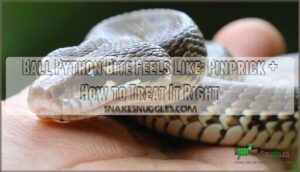
You’ll experience a brief, sharp sensation that’s surprisingly mild – most people compare it to a paper cut or getting pricked by rose thorns.
The pain typically lasts only seconds since ball pythons have small, backward-curving teeth designed for gripping rather than damage.
Don’t expect blood gushing like in movies; you’ll see minor puncture marks that barely break skin.
The initial shock often feels worse than actual pain.
Your reaction matters more than the bite itself – staying calm prevents those tiny teeth from causing tears when your snake releases its grip.
It’s essential to remember that the bite itself is relatively harmless, and the key to a positive outcome is staying calm and composed.
Table Of Contents
- Key Takeaways
- What Does a Ball Python Bite Feel Like?
- Bite Characteristics and Severity
- Reasons for Ball Python Bites
- Bite Prevention
- Bite Care
- Bite Rarity and Severity
- Frequently Asked Questions (FAQs)
- Are ball python bites painful?
- Why does my ball python Bite Me?
- What does a ball python bite look like?
- What happens if a baby ball python bites you?
- How long does a ball python bite pain last?
- Can a ball python bite cause an allergic reaction?
- Does getting bit by a python hurt?
- What is the bite force of a python snake?
- How sharp are ball python teeth?
- What does a carpet python bite feel like?
- Conclusion
Key Takeaways
- You’ll experience a ball python bite as a quick pinprick or needle jab that lasts only seconds – it’s surprisingly mild and feels more like a paper cut than a serious injury.
- You can prevent most bites by washing your hands after handling prey, avoiding nighttime handling when they’re more active, and recognizing warning signs like hissing or S-shaped neck positioning.
- If you’re bitten, stay calm and don’t jerk away since their backward-curved teeth can cause deeper tears – instead, let them release naturally and clean the wound with soap and water.
- You’ll find these bites are rarely dangerous and heal quickly within days, though you should seek medical attention if bitten on your face or throat where swelling could affect breathing.
What Does a Ball Python Bite Feel Like?
Most ball python bites feel like a quick pinprick or gentle pinch.
The bite pressure is surprisingly mild since their tooth shape is designed for gripping prey, not causing damage. Your pain tolerance doesn’t matter much—it’s rarely painful.
The snake bite sensation lasts only seconds, creating small puncture marks that barely bleed. Despite the venom myth, ball pythons aren’t venomous, so there’s no toxin concern.
A bite can occur if there’s a prey scent on hands. The psychological impact often exceeds the physical discomfort, as the surprise startles you more than the actual ball python bite pain.
Bite Characteristics and Severity
You’ll find that ball python bites feel remarkably mild, like a quick pinprick or needle stick rather than the dramatic wound you might expect.
Your reaction matters more than the bite itself—staying calm keeps the injury minor, while jerking away can turn tiny punctures into deeper scratches.
Pinprick Sensation
A ball python’s bite feels like a sharp needle prick or quick pinch.
On the bite pain scale, it rates as mild—similar to a bee sting.
Individual sensitivities vary, but most people describe the snake bite sensation as surprisingly gentle.
Tooth size impact and bite location matters affect intensity, creating minor puncture wounds rather than serious injury, which is why the bite is considered harmless.
Rarely Causes Damage
Most ball python bites result in minor wounds that heal quickly without complications.
Their small, backward-facing teeth create shallow punctures rather than deep gashes. When you experience a ball python bite, you’ll notice minimal bleeding and low pain levels.
The psychological impact often exceeds the physical damage – your initial shock usually hurts more than the actual bite. Ball pythons bite defensively, and understanding warning signs can help prevent such incidents.
Here’s what makes ball python bite severity so manageable:
- Shallow penetration – teeth rarely go deeper than skin surface
- Quick healing – most wounds close within days
- Low scarring potential – marks fade with proper care
- Minimal pain management needed – over-the-counter relief suffices
Staying Calm Minimizes Wound Severity
Your calm bite response is essential when a ball python latches on.
Controlled movements matter more than you’d think—panicking triggers muscle tension that worsens the bite.
Gentle removal techniques work best since ball python bites feel like pinpricks initially.
This harmless snake bite becomes problematic only when you jerk away, turning minor punctures into deeper lacerations through minimizing tissue damage.
Jerking Away Can Cause Lacerations
The instinct to pull away from a ball python bite can backfire.
Their backward-curved teeth act like tiny hooks, so jerking creates deeper wounds and increases tearing skin risk.
Here’s what happens when you panic:
- Tooth damage – Snake’s teeth may break off in your skin
- Deeper wounds – Hooks create longer tears instead of clean punctures
- Infection risk – Ragged wounds harbor more bacteria
- Scarring potential – Torn tissue heals poorly, leaving permanent marks
Reasons for Ball Python Bites
Your ball python doesn’t bite out of meanness – it’s usually confused or scared.
These gentle snakes typically strike when they mistake your hand for food or feel threatened by sudden movements or loud noises, which can be considered gentle actions under the circumstances.
Mistaken Identity as Prey
When your hands carry food scents, your python’s feeding response kicks in through scent confusion.
Your snake isn’t being aggressive—it’s simply following instinct.
Ball python bite feels like a quick pinch when prey association occurs during hand proximity.
| Common Scent Triggers | Risk Level | Prevention Method |
|---|---|---|
| Rodent handling | High | Wash hands thoroughly |
| Pet interaction | Medium | Use antibacterial soap |
| Food preparation | Low | Rinse before snake feeding |
Proper handling protocols prevent mistaken identity incidents entirely.
Feeling Threatened and Biting in Self-defense
Beyond mistaking you for prey, ball pythons bite defensively when they feel cornered or stressed.
Your snake’s temperament shifts when environmental enrichment is disrupted or handling techniques are too aggressive.
A ball python bite feels like a sharp pinprick during these defensive moments.
Here’s what triggers defensive behavior:
- Rough or sudden handling movements
- Startled reactions from unexpected disturbances
- Lack of regular human interaction
- Stress from enclosure changes
Watch for coiling and hissing – clear signs requiring immediate stress reduction through gentle retreat.
Bite Prevention
You can prevent most ball python bites by understanding what triggers them and adjusting your handling habits.
Simple steps like washing your hands after touching prey and recognizing your snake’s warning signs will keep both you and your pet safe, by following these simple steps.
Wash Hands After Handling Potential Prey
Your ball python might mistake your hand for dinner if it smells like prey.
Scent transfer from rodents triggers their feeding response, making a ball python bite more likely.
Hand hygiene with antiseptic soap removes prey odor completely.
This simple snake handling step can reduce bites substantially.
To guarantee proper hygiene, consider using products for hand washing.
| Before Washing | After Washing |
|---|---|
| Strong rodent scent | Clean, neutral smell |
| Confused snake | Calm snake |
| Higher bite risk | Lower bite risk |
| Feeding mode active | Normal behavior |
Avoid Handling Snake When Hungry or at Night
Timing matters in regards to safe interactions with your ball python.
Avoid nocturnal handling since these snakes are naturally more active and defensive at night. Similarly, don’t handle your snake when it’s hungry, as feeding schedules can trigger mistaken identity bites.
Watch for hunger cues like rapid tongue flicking or restless movement. Many owners find success with a consistent python feeding schedule to minimize hunger-related aggression.
- Smart timing prevents most ball python bite incidents – stick to daytime handling between meals for stress reduction and ideal snake behavior.
Recognize Body Language Signs of Hunger or Fear
Learning to read your ball python’s body language prevents most snake bite incidents before they happen.
Watch for these key hunger cues and fear signals: rapid tongue flicking means they’re hunting, while tight coiling indicates defensive mode.
An S-shaped neck position shows strike readiness – back away immediately.
Hissing sounds warn you they feel threatened, and these body language signs help you adjust your handling practices and avoid triggering aggression through proper snake behavior recognition, which is crucial for maintaining a safe environment and preventing incidents, by recognizing fear signals.
Return Snake to Enclosure if Showing Signs of Fear
When your ball python displays fearful behavior, immediately prioritize handling cessation for stress reduction.
A safe return to their enclosure prevents potential snake bite incidents and guarantees enclosure security.
Follow these steps for ball python care:
- Move slowly – Avoid startling your snake further
- Support their body – Gently cradle while lowering them
- Place carefully – Set them down in their familiar habitat
- Secure quietly – Close the lid without sudden movements
Handle Snake With Care and Avoid Sudden Movements
When your snake seems relaxed, gentle handling becomes your best defense against bites.
Slow movements and a calm demeanor help reduce stress and avoid startling your python. Think of it like approaching a sleeping cat – sudden gestures spell trouble.
| Do This | Not This |
|---|---|
| Support body evenly | Grab randomly |
| Move deliberately | Make quick motions |
| Stay relaxed | Act nervous |
| Watch body language | Ignore warning signs |
Proper snake handling prevents most ball python bites through mindful snake bite prevention.
Bite Care
When a ball python bites you, proper wound care prevents infection and helps healing happen faster.
You’ll need to clean the area right away and check for any teeth that might’ve broken off in your skin.
Wash Wound With Soap and Warm Water
Once you’ve been bitten, immediate wound care becomes your top priority. Clean the ball python bite thoroughly with warm water and antiseptic soap. This snake bite first aid step prevents infection and reduces complications from this non venomous bite.
Proper washing technique details matter for effective wound care:
- Use comfortably warm water – not hot enough to burn your skin
- Scrub gently with antibacterial soap for at least 30 seconds around the bite area
- Rinse completely to remove all soap residue before applying bandages
Check for and Remove Any Stuck Teeth
After cleaning your ball python bite, you’ll need to inspect for stuck teeth.
Ball pythons have up to 150 hooked teeth that can embed in skin during snake bite treatment.
Use sterile tweezers for tooth extraction, gently probing the wound.
If removal seems difficult, seek professional removal to prevent infection.
Proper wound care includes checking for tooth fragments that increase complications.
Ball python bites are typically mild, resembling a needle prick.
| Step | Action | Purpose |
|---|---|---|
| Inspect | Check wound for embedded teeth | Locate fragments |
| Extract | Use sterile tweezers carefully | Remove stuck teeth |
| Irrigate | Flush with saline solution | Dislodge remaining pieces |
| Assess | Evaluate extraction success | Confirm complete removal |
| Seek Help | Contact medical professional if needed | Prevent complications |
Apply Mild First-aid Disinfectant and Triple-antibiotic Ointment
Once you’ve removed any teeth, grab your first-aid supplies for proper wound cleaning.
Apply a mild antiseptic like hydrogen peroxide or rubbing alcohol to prevent snake bite infection. Next, dab a small amount of triple-antibiotic ointment on the ball python bite – this creates a protective barrier against bacteria.
Wash the wound with soap and water before applying any antiseptic.
- Antiseptic application kills harmful germs lurking in the wound
- Ointment benefits include faster healing and reduced scarring risk
- Infection prevention keeps your snake bite treatment simple and effective
Cover Wound With Bandage
Once you’ve applied antiseptic and ointment, bandage types matter for proper snake bite wound care.
Select a sterile adhesive bandage that covers the entire ball python bite area.
Secure it snugly without cutting off circulation – you want infection prevention, not a tourniquet.
Change the bandages daily while monitoring for redness or swelling.
Proper wound monitoring promotes healing and scar reduction for your minor snake bite.
Bite Rarity and Severity
You’ll find that ball python bites happen rarely since these snakes are naturally shy and prefer to hide rather than attack.
Most bites cause only minor scratches that heal within days, though you should seek medical help if you’re bitten on your face or throat, which can be a serious issue.
Ball Pythons Are Shy and Rarely Bite
Understanding ball python bite risk starts with recognizing their naturally timid disposition.
These gentle giants prefer hiding over confrontation, making bites extremely rare when you handle them correctly.
Ball python bite feels like a minor pinprick because their temperament versus morph shows consistent docility across all varieties.
Key factors reducing ball python bite risk:
- Shy snake myths don’t reflect reality – they’re genuinely docile creatures
- Handling reduces biting frequency through regular, gentle interaction
- Bite force myths exaggerate their actual strength capabilities
- Captivity affects behavior positively, creating calmer, predictable snakes
- Minor snake bite prevention works through understanding their peaceful nature
Bites Are Typically Minor and Heal Quickly
Most ball python bite incidents result in minor wounds that heal within days.
The bite discomfort duration is brief, typically lasting hours rather than days.
While infection risk factors exist if wounds aren’t cleaned properly, scarring potential remains low with basic care.
Simple pain management tips like over-the-counter medication help, making snake bite healing straightforward for most people.
Bites often occur due to a snake’s defensive behavior.
Face or Throat Bites May Require Medical Attention
Though most ball python bites heal without fuss, face or throat snake bites demand immediate attention.
These locations pose serious risks that shouldn’t be ignored. Ball pythons are non-venomous, but defensive bites can still be problematic.
- Airway Obstruction: Swelling near your throat can restrict breathing
- Nerve Damage: Facial nerves control expression and sensation
- Infection Risks: Bacteria can spread quickly in head tissues
- Scarring Potential: Visible marks affect appearance and confidence
Snake bite symptoms in these areas warrant professional snake bite treatment immediately.
Bites Are Inconsequential in Most Cases
Most ball python bites are surprisingly inconsequential, causing more psychological impact than physical harm.
Your first snake bite might feel alarming, but these small snake bite incidents rarely require serious medical intervention.
Ball python teeth create minor bite risks with minimal ball python bite symptoms, thanks to quick healing and natural bite harmlessness, most people discover their pain tolerance easily handles these gentle encounters.
Frequently Asked Questions (FAQs)
Are ball python bites painful?
Most ball python bites aren’t particularly painful – they’ll feel like a sharp pinch or needle prick.
You’ll notice the initial surprise more than actual pain, since their small teeth create minor scratches rather than deep wounds, and this is due to the surprise.
Why does my ball python Bite Me?
Most ball python bites happen when they’re hungry and mistake your hand for food.
You’re likely being bitten because of feeding responses, stress, improper handling, or residual prey scent on your hands.
What does a ball python bite look like?
A ball python bite leaves small, curved scratches or puncture marks resembling a crescent shape.
You might see slight bleeding and redness, but it’s usually minor—more alarming than harmful at first glance.
What happens if a baby ball python bites you?
Like a gentle bee sting, a baby ball python’s bite feels like tiny pinpricks.
You’ll experience mild scratching rather than deep punctures.
Simply wash the small wounds with soap and water, then apply antiseptic to prevent infection, which is a crucial step after feeling the bite that is like tiny pinpricks.
How long does a ball python bite pain last?
Pain from a ball python bite typically lasts just a few minutes to an hour.
You’ll feel initial sharp pinching, then mild throbbing or burning.
Most discomfort fades quickly since they’re non-venomous.
Can a ball python bite cause an allergic reaction?
Unlike a bee’s sting that triggers widespread reactions, you’re unlikely to experience allergic responses from ball python bites.
These non-venomous snakes don’t inject allergens, though standard wound infections remain possible without proper care, which can lead to infections.
Does getting bit by a python hurt?
Yes, you’ll feel a sharp pinch similar to a needle prick when a python bites.
The backward-facing teeth create small punctures that may bleed slightly, but it’s typically more surprising than truly painful.
What is the bite force of a python snake?
Ever wonder how hard a python can squeeze?
You’re looking at bite forces ranging from 200-400 PSI for ball pythons, while larger species like Burmese pythons pack 500+ PSI – that’s stronger than most dog bites!
How sharp are ball python teeth?
Ball python teeth are razor-sharp with backward-facing hooks, measuring about 1 cm long.
You’ll find 100-150 of these needle-like teeth designed to grip prey.
They’re barbed and curved inward, creating multiple puncture wounds when they bite.
What does a carpet python bite feel like?
A carpet python’s "love tap" feels like sharp needle pricks followed by firm pressure.
You’ll experience multiple puncture wounds from backward-curved teeth, creating a pinching sensation that’s more startling than severely painful.
Conclusion
Like touching a cactus needle, a ball python bite feels like a brief pinprick that’s more surprising than painful.
You’ve learned that proper handling prevents most bites, and quick first-aid treats any that occur.
These gentle serpents rarely bite, and when they do, it’s typically harmless.
Remember to stay calm, wash the wound, and apply basic care.
With knowledge comes confidence – you’re now prepared to handle your ball python safely while understanding exactly what a ball python bite feels like.


